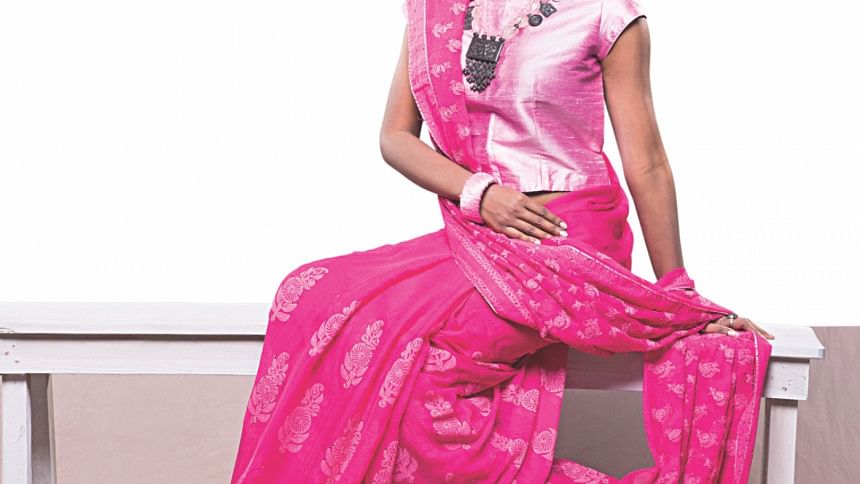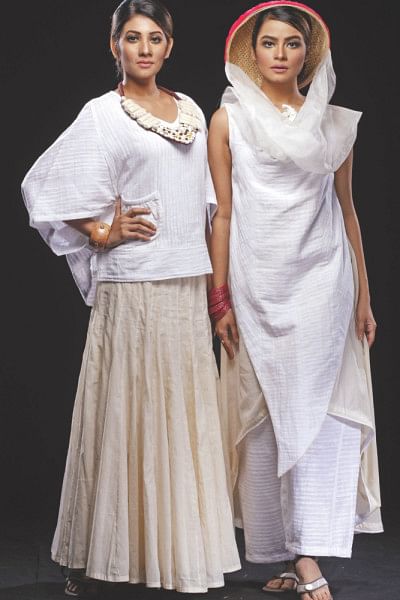Culture: a narrative of changing mores

Fashion trends are a narrative of the innate culture of a people, and it is no different for Bangladesh.
Cultural history is a combined narrative of anthropology and history, with consideration for popular cultural traditions and cultural interpretations of historical experience, especially in Bangladesh. Culture can be seen as a moral and exclusivist code that sketched distinctions between social and ethnic groups by indicating culturally orthodox works of art and literature; as well as the development of a collective sensibility to appreciate those.
Examples of what can be seen as cultural history have existed throughout the modern era, but, most of these are personalised or journalistic accounts by various historians. There are also many examples of histories of cultural developments like music, art, literature, and ideas, that could be counted as cultural history, when defined broadly.
What this adds to the current discourse is the comprehension that our ideas of culture stem from our own interpretations and the source of an idea needs to be thoroughly analysed. It brings to the fore the idea that while one society may differ from another society, there are further distinguishing factors within those very own soceites.
For instance, where classical cultural historians focused on elite culture and emphasised the autonomy of artistic and literary works, these days culture is defined by the attention that critics and audiences bestow on certain aspects of our culture, both of whom see through the lenses shaped by broader social and cultural developments.

While it is quite notable that Bangladesh has uninterrupted periods of history where major strides have been made in the realm of art and architecture, when it comes to "world art", our representation on the world stage can be classified as negligible. When we have managed to garner enough attention to deserve our narrative on art and architecture, it has been plagued with generalisations such as "all architecture has been religious", followed by the accusation that this appropriated falsehood has somehow prevented Bengal art and architecture from reaching the dizzying heights of grandeur.
Our Secular Architecture
A few points need to be made here. These are best explored in a paper titled "The Cultural and Architectural History of India", (Singh and Kumar, 2016). Since the period discussed included the Indian sub-continent including Bangladesh, the facts can be used to explain what Bengal observed as well.
"Much of Bangladesh's oldest secular architecture has not survived because it was built from wood. Stone was a cumbersome and time consuming material for construction, and given the intense heat, it is a particularly unsuitable material for closed construction. That is why stone was used primarily for buildings where much of the activity would take place in an outdoor setting. However, anecdotal accounts of Chinese travelers, surviving literature and court histories, ancient sculptural finds - all indicate that Bangladesh was not lacking in secular buildings, many of which were embellished with architectural ornamentation and painted in naturally available colours."
Philosophical content of Bangladeshi art
Bengal, at the time, also had a prevailing and rich tradition of philosophy, based on both rational and spiritual ideas. These found their way into architecture as well. Stupas and temples actually embraced these elements via a symbolic language based on purely visual representation of their beliefs. These included "the Chakra - the revolving wheel of time which symbolised the cyclical rhythms of the cosmos; the Padma - or the lotus symbol which embodied the prime symbol of creation - of the universal creative force that springs from the bosom of the earth; the Ananta symbolised water - the most important life-giving force and the infinite ocean from which all life emerged, got differentiated and then got re-merged and redissolved; the Swastika - representing the four-fold aspects of creation and motion; the Purnakalasa - or the overflowing water pot - a symbol of creativity and prosperity; the Kalpalata - the wish-fulfillment creeper or tree that were also symbols of imagination and creativity; Gavaska - sometimes understood to be the third eye; lingam and yoni - the male and female fertility symbols." It is prudent to address here that the Stupas and temples also served as cultural centres, having both spiritual and secular significance. It was nothing like a church or a synagogue, which have more focused sphere of activities.
The Decorative Arts and Crafts
But in the realm of the decorative arts and crafts, Bengal's legacy had few challengers. The Mughals were especially great patrons of the decorative arts, and although initially it appears they may have favoured imports from Persia and China, manufactures here in Bangladesh rapidly perfected and enhanced imported styles and techniques. Our textiles had always been known for their rich colors and variety of design. But very rapidly also emerged as a preeminent centre for a variety of fine arts and crafts, excelling in the manufacture of all manner of objects sought by the royalty including decorated silver ware, fine jewellery, textiles and terracotta art.
The role of folk art in the Bangladeshi artistic tradition:
As brought out earlier, one of the most endearing aspects of Bangladeshi art and architecture prior to colonisation has been the strong impact of folk idioms and folk art on courtly art. Although folk art received little encouragement during the period of colonisation, independence brought forward a renewed interest in folk paintings. Historically, folk artists not only provided an important recreational service in village and urban communities, they helped preserve cultural traditions through their illustrations of love stories, popular ballads, epics and folk-tales. Along with playwrights and poets, they were instrumental in the spread of social values and ethics, and religious and philosophical ideas that had popular appeal.
But above all, owing to their close contact with the masses, their paintings were often infused with a warmth and attractive simplicity that more than made up for any lack of formal grace or technical brilliance. And in some ways, it is the widespread penetration of the folk idiom into courtly traditions that has been the outstanding hallmark of our art, and gives it it's highly characteristic flavour.

Jamdani a royal figured muslin: Weaves of Bangladesh
A legend says that Emperor Aurangzeb went into fit of rage when, one day he saw his daughter wearing nothing. On his rebuke, she replied that she is wearing not one, but seven layers covering her body. She wore cotton muslin. Such was the fineness of the Bangladeshi hand woven fabrics( R. Nath: History of Decorative Art in Mughal Architecture).
Jamdani is one of the most beautiful textiles of Bangladesh. Jamdani means, a vase of flowers. History of this fabric dates back to the early ages, wherein mentions of the fabric are seen scripted in archives of the trading tradition. The glory of this fabric can also be seen mentioned in the writings of Chinese, Italian, and Arab travellers. It is no wonder that the great Roman emperors paid remarkable prices for Bengal's "mul mul" fabrics.
Basically this fabric is weaved of unbleached cotton yarn. Intricate designs are woven into the fabric with bleached cotton yarn, creating a light and dark effect in coours. Weaving methods resemble the tapestry work where small shuttles of gold and silver colored threads are passed through the weft.Walking through the villages of Bangladesh, even today, one can hear the magical incantations of the wevers' looms in motion, the rhythmic singing of shuttles making the musical 'tak-tak'. This sound has reverberated in our clothing culture for the past 2000 years. Hand woven fabrics have been romanticised and reviled for its culture, virtues, and intonations of repression of workers since time immemorial. Despite globalisation and technology, this craft has its own evergreen place in the minds of culture lovers.
Jamdani is a vividly patterned, sheer cotton fabric, traditionally woven on a handloom by craftspeople and apprentices in the areas around greater Dhaka. Jamdani textiles combine intricacy of design with muted or vibrant colours, and the finished garments are highly breathable. Jamdani is a time-consuming and labour-intensive form of weaving because of the richness of its motifs, which are created directly on the loom using the discontinuous weft technique. Weaving thrives today due to the fabric's popularity for making saris, the most revered dress of Bangladeshi women at home and abroad. The Jamdani sari is a symbol of identity, dignity and self-recognition and provides wearers with a sense of cultural belongingness and social cohesion. The weavers develop an occupational identity and take great pride in their heritage; they enjoy social recognition and are highly respected for their skills. A few master weavers are recognised as bearers of the traditional Jamdani motifs and weaving techniques, and transmit the knowledge and skills to disciples. However, Jamdani weaving is principally transmitted by parents to children in cottage based workshops. Weavers – together with spinners, dyers, loom-dressers and practitioners of a number of other supporting crafts – form a closely knit community with a strong sense of unity, identity and continuity.
Nakshi Kantha:
The quilting tradition of Bangladesh
Nakshi Kantha, the traditional needlecraft of Bangladesh, displays a rich vocabulary of motifs. These motifs are deeply rooted in strong religious beliefs and underlay a strong symbolism. These motifs signify the desire for self expression and manifestation of the artisan's aspirations. It was and is more than just a decorative quilt; they were the canvas for self-expression, their values and beliefs. Furthermore, use of these symbols display a keen desire to establish their own identity and position in the society and the urge to manifest their aspirations through religious symbolism, direct depiction and aesthetic display. Tree of life, Lotus and Fish have been three of the most popular and mindfully chosen motifs.
Kantha displays extraordinary creativity, curious motifs and immense amount of patience. The most endearing gift exchanged at birth, death or marriage, the seat of honour offered to welcome guests, the mark of respect for the dead, the wandering fakirs drape, the personal wallet for carrying little valuables or a wrap for any other precious possession, Kantha in Bangladesh is not any frozen art stored behind museum glass, it is an integral part of the lives of the country folk and is a living art form.
Most research on Kantha have not been able to date the craft. Kantha was a craft of the poor and did not get recognition as a craft for a long time. The most poetic reference of Kanthahas been found in Poet Jasimuddins Poem 'Nakshi Kanthar Math.' The earliest mention of Bengal Kantha is found in the book, "Sri Sri Chaitanya Charitamrita" by Krishnadas Kaviraj which was written some five hundred years ago. The second earliest reference is found with Abanindranath Tagore, who seemed to have encountered a woman in a village in a district of Srihatta of Bangladesh, who recorded her life story in her Kantha spanning a period starting from her marriage to old age.
In style, form, fabric or technique, through sheer skill and patience the Bangladeshi women have been able to create stunning patterns by employing the most simple and frugal methods. The Kantha is really a play of the ordinary running stitch used in its myriad variations. Through variation in its length and spacing, a surface composed of multitudes of squares and triangles is created that has a marvellous speckled texture. (C.R Das, Semoitic Study of The Motifs of Nakshi Kantha-The Tree of Life, The Fish and The Lotus, http://www.craftrevival.org, 2010, (accessed 1st February, 2017)
Today over 60,000 women are formally producing Kantha as a income generating activity. It has also graduated from focusing on mere household quilts to fine pieces of decorative textile art. It is also a great source of inspiration for couture saris and dress goods.
Silk Weaves of Bangladesh
The Arthashastra has mentioned that silk weaving in Bangladesh has existed from the ancient times. The cultivation of mulberry silk and its weaving is carried out in the plains of North West Bangladesh, predominant in Chapai Nawabganj and adjacent districts. Rajshahi on the north bank of Padma river is today the most important centre for silk rearing in Bangladesh.
The silks were originally used by Nawabs and Muslim aristocrats of the Sultanate period and later adopted by the elite. Hindu noblemen also used the raw silk for there stitched garments. Mulberry silk was woven into saris where the borders were narrow with floral and foliage motifs and the fall of the sari was covered with small paisley and other floral designs in undemonstrated but bright colour schemes. Another familiar motif for the body of the sari was diagonal butis. Even today similar saris which have smaller anchals are being woven at the weaving centres to match contemporary tastes.
Rajshahi is famous for its 'Garod'. Saris made of fine mulberry silk with flat, deep- red or blue borders made with three shuttles. The borders were laced with fine serrated design in gold zari. The fine gold lines are supposed to represent the fine trail left on its path by the spirits of divine angels. 'Motka', a form Khadi Silk, preceded 'Garod' of Rajshahi. Today there are many applications hand-painted designs and embroidered and printed materials.
Handloom Green Textiles
Khadi is the homespun symbol of freedom and recenly it has come out with a new attitude at the fashion event --Khadi Festival-- a celebration of aesthetic character of this quintessentially Bangladeshi textile.
Can we call khadi redundant, since it originated in a social and political context that does not exist today, or because as a symbol, it is no longer relevant? Or does it glorify poverty? – are apparently reflections of Khadi in the current context.
While that may be the perception, khadi can also be used as a powerful tool; and no one does this better than our new generation of designers. The fabric itself does take your breath away. As "Everyone is carried away by the romance of khadi and it is really flawless ideologically."
The nub of the issue however, is the feel of the fabric. Many of us urban Bangladeshis like the idea of wearing khadi. But the fabric itself is nubby, thready, thick, and yes, flawed. Shoba Natayan discussed this the best. "Ironically, true connoisseurs love these flaws because they reveal the fact that it is handmade. Imperfection is the hallmark of the hand. It is only soulless machines that can spin out yard after yard of perfectly alike and aligned yarn. When humans get involved with their hands and minds, the fabric changes. Not all of us have the ability or even the desire to appreciate khadi's subtlety. Nuance is the purview of poets, not engineers. Khadi is flawed, yes, but that is its brand identity, its charm and indeed the reason it is today a luxury fabric. Unlike mill-woven cloth, khadi gets softer with each wash. Home-grown textiles, much like local crafts, are children of the economy." (Narayan S, 2010) When a nation's GDP flourishes, so do its indigenous folk arts, crafts and textiles. With Bangladesh's ever thriving and confident middle class starting to look inward for its style cues, design mantras and textile techniques, you could argue that khadi is ripe for a reincarnation. A rising number of young fashion designers are seeking out local fabrics, crafts and techniques, using hand loom. Then why aren't more of us wearing khadi?
Maheen Khan is a fashion designer at the helm of Mayasir.
Model: Priyam, Masiyat, Risila
Wardrobe: Mayasir

 For all latest news, follow The Daily Star's Google News channel.
For all latest news, follow The Daily Star's Google News channel. 



Comments